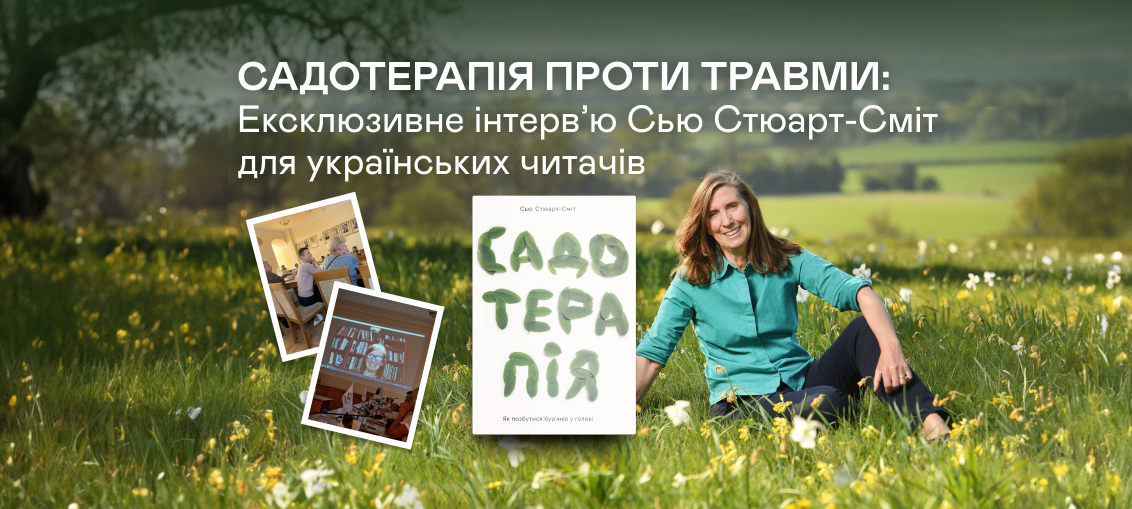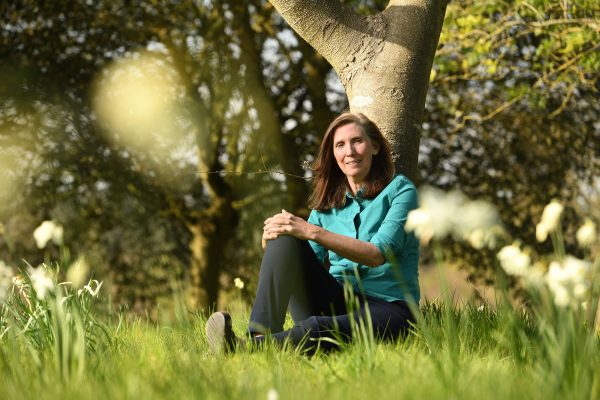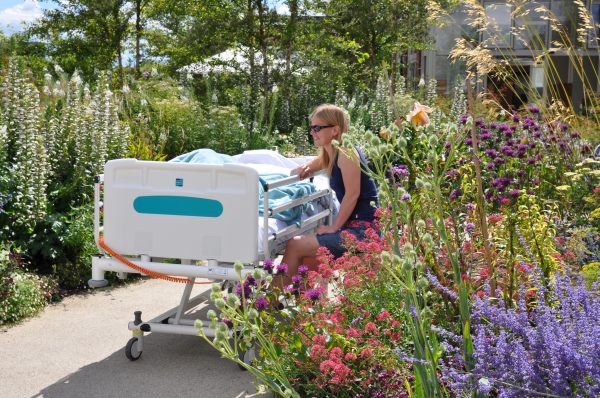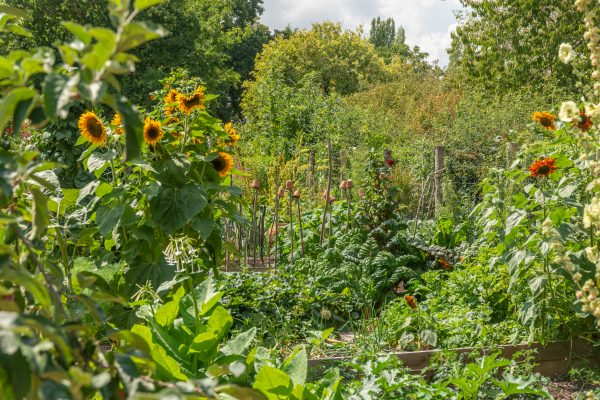
Книжка “Садотерапія. Як позбутися бур’янів у голові” вийшла в українському перекладі у видавництві Yakaboo Publishing ще 2021-го року. Тепер можна сказати: дуже вчасно, аби стати у пригоді багатьом українцям. У ексклюзивному інтерв’ю видавництву Сью Стюарт-Сміт, авторка книги, знана психотерапевтка та садівниця, розповідає про користь методу для українців, травмованих війною.
Нижче публікуємо англомовну версію матеріалу.

Метод садової терапії для країни у війні
Мабуть, одним з найкращих свідчень користі садової терапії у воєнний час є історичні приклади, коли садівництво надавало психологічну підтримку. Перша світова війна, з її жахливими руйнуваннями, продемонструвала, наскільки сад може відповідати на найглибші екзистенційні потреби людини. Садівництво стало важливим не лише у тилу, для вирощування агропродукції, а й в зоні бойових дій, де солдати Західного фронту створювали невеликі сади в окопах. Вони вирощували яскраві та знайомі квіти, такі як іпомея, незабудки та чорнобривці. Вирощування рослин стало спонтанною реакцією на травми та смерть, що допомагала солдатам подолати страх і відчай.
Після тієї війни, через велику кількість поранених і постраждалих військовослужбовців, а також високий рівень психологічних травм, які вони зазнали, розвинулися реабілітаційні програми, особливо в Великій Британії та США. Цей період став початком садівничої терапії, попри те, що цей термін не використовувався до 1950-х років.
Після Другої світової війни видатний американський психіатр Карл Меннінгер почав працювати з травмованими ветеранами в Канзасі. Він був вражений тим, як робота з рослинами допомагала його пацієнтам повернутися до повсякденного життя. Програма лікування, яку він розробив у клініці міста Топіка, включала медикаментозне лікування та психотерапію, але садівництво також було ключовим елементом програми. Меннінгер заснував першу офіційну навчальну програму з садівничої терапії і протягом усього свого життя пропагував терапевтичну силу садів. Він описував садівництво як діяльність, “яка наближає людину до землі, до матері-природи, до краси, до незбагненної таємниці росту і розвитку”.

Суть методу: як сад лікує душу
Особливі якості садового простору і садового часу означають, що садівництво можна розуміти як форму просторово-часової медицини. Просторові якості саду розширюють наше відчуття ментального простору, а процес садівництва змінює наше ставлення до часу.
Першим кроком будь-якого лікування травми є відновлення відчуття безпеки. Цей початковий етап є фундаментальним і означає, що безпечне просторове середовище саду є терапевтичним інструментом.
“Заземлення” та усвідомленість
Садівництво також має терапевтичний вплив і змінює наше сприйняття часу. Ритмічні дії з прополки та посіву допомагають занурити нас у теперішній момент. Таким чином, садівництво може бути “усвідомленим” заняттям. Доведено, що стан такого усвідомлення притлумлює сигнали до центру страху в мозку, мигдалеподібного тіла, і допомагає відновити більш цілісний стан нейронної активності в мозку. Це дає людині відчуття спокою.
Надія та очікування
Важливо те, що садівництво завжди орієнтоване на майбутнє. По суті, це акт надії. Посів насіння дозволяє нам докласти руку до самих початків життя, і ми з нетерпінням чекаємо на результат з позитивним відчуттям. Така орієнтація на майбутнє допомагає дивитися вперед у часи, коли майбутнє здається похмурим або тривожним.
Таким чином, садівництво може стати простим способом відновити почуття позитивного очікування, що, своєю чергою, може відновити мотивацію та цілеспрямованість. Передчуття винагороди, наприклад, коли ми з нетерпінням чекаємо на вирощені нами плоди та квіти, пов’язане з вивільненням дофаміну в мозку, який має енергійний і мотивуючий вплив на нас.
Творчість та контроль
Сад – це доступний спосіб відчути радість творення, оскільки не вся творчість належить лише нам, людям. Садівництво – це зустріч двох творчих енергій: людської і природної. Так, ми не завжди можемо повністю контролювати ситуацію, але, тим не менш, сад стає частинкою реальності, яку ми все ж можемо формувати і визначати. Це усвідомлення надихає і стабілізує.
Турбота і прив’язаність
Сад – це жива сутність, і садівництво передбачає формування стосунків з місцем і рослинами, а також налаштування на їхні потреби. Садівництво може допомогти нам культивувати дбайливе ставлення до природи. Система турботи в мозку пов’язана з відчуттям безпеки, а її нейрохімія породжує відчуття внутрішнього спокою. Це пояснюється тим, що піклувальна діяльність пов’язана з вивільненням наших природних опіоїдів – ендорфінів, які заспокоюють і піднімають настрій, а також притлумлюють психологічний і фізичний біль. Гормон окситоцин також присутній у стосунках догляду і має прямий антистресовий ефект через заспокійливу дію на центр страху в мозку, що знаходиться в мигдалеподібному тілі.
Доглядаючи за садом, ми вбудовуємось у мережу життя і можемо відчути себе частиною чогось набагато більшого, ніж ми самі. З часом формування прив’язаності до місця має стабілізуючий ефект і згодом сад може стати невід’ємною частиною нашої ідентичності.

Користь прогулянок і споглядання природи
Якщо людина не має змоги працювати в саду, чи матиме терапевтичний ефект лише споглядання природи, прогулянки по парку? Так, матиме. Але деякі з переваг садівництва будуть відсутні.
Людський організм еволюційно сформувався у саваннах Африки, тому наша нервова та імунна системи розвинулись так, щоб краще взаємодіяти з природними аспектами навколишнього середовища. Сюди входять ключові елементи, такі як сонячне світло, вода та зелень, які ми сприймаємо як відновлюючі та позитивні.
Природні умови мають прямий позитивний вплив на нашу вегетативну нервову систему. Вона працює у два способи: через симпатичний імпульс, що активується адреналіном і спрямований на відповідь на стрес, а також через відновлювальний парасимпатичний імпульс, який стимулює одужання та травлення.
З еволюційної точки зору, стресова реакція є механізмом виживання, який спрацьовує як сигнал до дії в умовах небезпеки. Вона готує організм до реагування, підвищуючи ритм серця, тиск, вивільняючи глюкозу та прискорюючи дихання. Якщо небезпека не зникає, активується гормон стресу – кортизол.
Для здоров’я важливо, щоб обидві вегетативні системи гнучко взаємодіяли між собою. Прогулянки на природі допомагають відновити цей баланс, знижуючи рівень збудження організму. Дослідження показують, що вже за декілька хвилин знижується ритм серця та артеріальний тиск, а також зменшується гнів і страх. Рівень кортизолу, гормону стресу, зазвичай знижується за 30 хвилин.
Тому важливо щодня приділяти час усвідомленому сприйняттю навколишнього світу природи.

З чого почати?
Перш за все: чи потрібен фахівець, який вестиме людину у садотерапі? Висловлю припущення. Для деяких груп терапевтичний внесок спеціаліста має вирішальне значення, але загалом люди різного віку і в різних ситуаціях можуть отримати користь від садівництва.
Перші кроки у садотерапії
Якщо ви новачок у садівництві, найкраще вирощувати те, що додасть вам впевненості і відносно швидко дасть результат – наприклад, настурції та редис, які легко вирощувати.
Якщо ж у вас немає саду, ви все одно можете принести зелену природу в дім, вирощуючи зелень на підвіконні, або поставивши квіти чи кімнатні рослини в оселі. Також варто згадати про можливість долучитися до місцевих громадських проєктів з озеленення. Крім того, поруч з вами можуть бути невеликі ділянки порожньої землі, які можна обробляти. Багато міських ініціатив з озеленення вже реалізуються в містах по всьому світу. Одним з найбільш надихаючих є проект «Неймовірно їстівний Тодморден» біля Манчестера, який я описала у своїй книзі.

Наукові докази ефективності садової терапії
Протягом останніх десятиліть було проведено кілька досліджень, які показали, що садівництво може полегшувати стани депресії, стресу і тривоги, а також сприяє підвищенню самооцінки. Важливо зазначити, що якість та обсяг цих досліджень значно різняться.
Існує невелика кількість випадкових (рандомізованих) контрольних досліджень. Одне з них було опубліковане у 2018 році в Британському журналі психіатрії і вперше в ньому розглядалася терапія садівництвом. Програма лікування садівництвом тривала 10 тижнів, і навіть за такий короткий період її учасники відчули такі ж позитивні зміни, як і при застосуванні когнітивно-поведінкової терапії, яка має наукове підґрунтя.
Втім більшість спостережень тривала відносно недовго, а це ускладнює виявлення довгострокових переваг, пов’язаних зі змінами у переживанні всіх сезонів року.
У 2016 році Королівський фонд у Лондоні опублікував огляд літератури про вплив садівництва у різних сферах охорони здоров’я з тим, щоб відкоригувати стратегії охорони здоров’я та прийняття терапевтичних рішень. Ще одне дослідження, спрямоване на зміни у політиці охорони здоров’я, було опубліковано у 2020 році в Британському медичному журналі. Цей мета-аналіз включав огляд результатів 77 досліджень, в тому числі 8 рандомізованих контрольних досліджень. Автори дійшли висновку, що наявні докази підтримують використання садівництва як дієвий засіб для людей з довгостроковими потребами у сфері охорони здоров’я.
ENGLISH VERSION
GARDEN THERAPY AGAINST TRAUMA: Exclusive interview with Sue Stuart-Smith for Ukrainian readers
The book “The Well Gardened Mind: Rediscovering Nature in the Modern World” was published in Ukrainian translation by Yakaboo Publishing in 2021. Now we can say: it is very timely to be useful to many Ukrainians. In an exclusive interview with the publishing house, Sue Stuart-Smith, the author of the book, a well-known psychotherapist and gardener, talks about the benefits of the method for Ukrainians traumatized by the war.

Garden therapy for a country at war
Perhaps the best indicators of the usefulness of garden therapy during wartime are historical examples in which gardening has offered a psychological lifeline. The appalling destruction of the First World War, in particular, revealed the power of the garden to answer to humankind’s deepest existential needs. Gardening was important not only in the victory food growing movement at home, but also on the front lines when soldiers on the Western Front created small gardens in the trenches. They grew colourful and familiar flowers like morning glory, forget-me-nots and marigolds. In that landscape of trauma and death, cultivating the earth was a spontaneous response that helped the soldiers manage fear and despair.
Following that war, the huge number of wounded and traumatised service men and the extent of psychological damage many had suffered led to the development of land-based rehabilitation programmes especially in the U.K. and US. This period marks the beginnings of horticultural therapy, although it was not called that until the 1950’s.
Following the Second World War, the eminent American psychiatrist, Karl Menninger began working with traumatised veterans in Kansas. He was impressed by the extent to which working with plants helped his patients open themselves back up to life. The treatment programme he developed at the Topeka Clinic included medication and psychotherapy, but gardening was also a central to the programme. Menninger established the first formal training programme in horticultural therapy and throughout his life, he promoted the therapeutic power of gardens. He described it as an activity ‘that brings the individual close to the soil and close to Mother Nature, close to beauty, close to the inscrutable mystery of growth and development.’

The essence of the method: how a garden heals the soul
The particular qualities of garden space and garden time mean that gardening can be understood as a form of space-time medicine. The spatial quality of a garden expands our sense of mental space and the process of gardening alters our relationship with time.
The first step of any trauma treatment is to recover a sense of safety. This initial stage is fundamental and means that the safe spatial setting of a garden is a therapeutic tool in its own right.
Being mindful
The work of gardening is therapeutic too and alters our relationship with time. The rhythmical activities of weeding and sowing help to bring us into the present moment. In this way gardening can be a ‘mindful’ activity. States of mindful awareness have been shown to decrease signals to the fear centre of the brain, the amygdala, and help restore a more integrated state of neural activity within the brain. This gives rise to feelings of calm. A sense of fresh perspective can follow from the increase in brain connectivity.
Hope and future
Crucially, gardening is always orientated towards the future. Fundamentally it is an act of hope. Sowing seeds allows us to have a hand in the very beginnings of life and we look forward to the outcome with a sense of positive anticipation. This future orientation helps people look forward at times when the future feels otherwise bleak or full of anxiety.
This means that gardening can provide a simple way of recovering a sense of positive anticipation and this in turn can lead to a recovery of motivation and a sense of purpose. Anticipation of reward, for example when we look forward to the vegetables or flowers we have grown, is linked to release of dopamine in the brain which has energizing and motivating effects on us.
Creativity and control
A garden provides an accessible way to experience the joy of creating because not all the creativity is ours: gardening is what happens when two creative energies meet, human creativity and nature’s creativity. This means we are never fully in control but nevertheless a garden provides a little portion of reality which it is possible to shape and determine. This can be empowering and stabilising.
Care and bonding
A garden is its own living entity and gardening involves forming a relationship with place and plants and tuning in to their needs. Gardening can help us cultivate an attitude of care. The care system in the brain is associated with feeling safe and its neurochemistry gives rise to a sense of inner calm. This is because caring activities are associated with release of our natural opioids, the endorphins, which have an effect of soothing and lifting mood as well as reducing psychological and physical pain. The hormone oxytocin is also intrinsic to the care system and has a direct anti-stress effect through a damping action on the brain’s fear centre in the amygdala.
Through caring for a garden, we are connected to the web of life and can feel part of something much larger than ourselves. Over the course of time, the formation of an attachment to place has a stabilising effect and means that a garden can become woven into our sense of identity.

The benefit of walking and contemplating nature
If a person is not able to work in the garden, will only contemplation of nature and walks have a therapeutic effect? Yes it will. But some of the benefits of gardening will be missing.
As a grassland species which emerged in the savannah landscapes of Africa, our nervous systems and immune systems have been primed to function best in response to various aspects of the natural world. This includes basic elements such as sunlight, water, and greenery which we experience as restorative.
Natural settings have a direct beneficial effect on the autonomic nervous system. This has two modes of action: the adrenalin fuelled, sympathetic drive which is coordinated by the amygdala, the fear centre located deep within the brain and the opposite, restorative parasympathetic rest-and-digest, system that generates recovery.
In evolutionary terms the human stress response is a survival tool because it acts like a signal prompting us to take action in the face of danger and prepares us to react by raising our heart rate and blood pressure, releasing glucose and speeding up our breathing. Following on from this, if the threat persists, the stress hormone cortisol is released.
What is important for health is that the two autonomic systems are able to balance each other in a flexible way. Spending time in nature helps to restore that balance by bringing the body to a lower level of arousal. Studies have shown a lowering of heart rate and blood pressure within minutes and also reduced feelings of anger and fear. Levels of the stress hormone cortisol typically start to drop after 30 minutes.
The important thing is to spend some time each day in mindful appreciation of the natural world around you.

How to start
First of all, is the garden therapist`s presence mandatory or we can do gardan therapy on our own? I don’t feel I can answer this. It will only be speculation. For some groups specialist therapeutic input is crucial but generally people of all ages and situations can derive benefit from gardening.
First steps
If you are new to gardening, it’s best to grow things that are dependable and which will boost your confidence and give you results relatively quickly – nasturtiums and radishes, for example, are easy to grow.
And if you don’t have a garden, you can still bring green nature inside by growing herbs on the windowsill, or introducing flowers or potted plants into the house. There may be a local community garden project you can get involved. Alternatively there may be small plots of vacant land that could be cultivated. Many urban gardening movements have done this in cities around the world. One of the most inspiring is the Incredible Edible project in Todmorden near Manchester which I describe in my book.

Scientific evidence for the effectiveness of garden therapy
A number of studies published over the last few decades have shown that gardening helps to alleviate depression, stress and anxiety and improve self-esteem but the quality and size of the studies is very varied
There are a small number of randomised control trials in existence. One of these was published in the British Journal of Psychiatry in 2018, the first time that horticultural therapy has been included in its pages. The garden treatment program was 10 weeks in length and even for this relatively brief period, the gardening participants derived a similar level of benefit as the evidence-based Cognitive Behavioural Therapy program.
But the majority of research studies are conducted over a relatively brief time frame like this which inevitably makes it hard to capture any longer-term benefits linked to experiencing the full cycle of the seasons.
In 2016, the Kings Fund in London published a literature review of the effects of gardening across a wide range of health applications with the aim of helping to guide healthcare strategy and decision making. Another publication aimed at influencing health policy emerged in 2020 when the British Medical Journal published a meta-analysis of research on gardening. This review of international research analysed the findings of 77 studies, including 8 randomized controlled trials. The authors concluded that the existing evidence supported using gardening as form of social prescription for people with longer term health needs.



